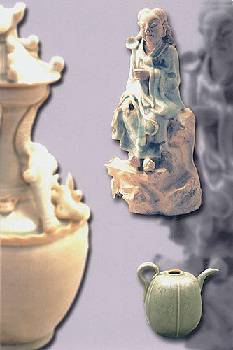Site of celadon kiln in the Southern Song Dynasty (1127-1279)
Location:Longquan County,ZhejiangProvince
Period: 1127-1279
Excavated in 1959
Significance: It has supplied important material objects to the study of the production, types, styles and craftsmanship of the Longquan celadon during the Southern Song Dynasty.
 Introduction
Introduction
The Longquan Kiln, located inLongquan County,ZhejiangProvince, is one of the most famous kilns in the Song Dynasty. The Longquan Kiln, first built in Five Dynasties, produced vases, kettles, jars and plates with vases having the richest varieties.
|

|
| Celadon figurine of He Xian Gu (one of the eight immortals connected with Taoism): decorative object (up, height 17.5 cm); Celadon water dropper in the shape of squash: tea set (bottom, height 16.5 cm) |
Longquan Kiln inherited the traditional technique of Yue Kiln. In the Northern Song Dynasty, the glaze on Longquan ware was so thin that it looked translucent. Most of the decorations were carved flowers. But during its florescent period in the Southern Song and Yuan dynasties, the glaze became thicker and had several layers, being less translucent or non-translucent. The glaze looked so watery that no carved flower decoration was needed.
It was during the Southern Song Dynasty, the kiln's technique had its own characteristics. The pale blue glaze and plum green glaze were clear and mild just like jade, reaching the peak of celadon. It became another celadon kiln series after the Yue Kiln. Its products, becoming more and more popular, had been sold home and abroad. Since the mid-Ming Dynasty (1368-1644) Longquan Kiln began its decline due to the prosperity of Jingdezhen Kiln.
 Six Kiln Factions and Five Famous Kilns
Six Kiln Factions and Five Famous Kilns
The Song Dynasty is the third prosperous period of Chinese feudal society. Technology, culture, art and handicraft were highly developed. The ceramic industry was prosperous too. Porcelain kilns with vivid region feature spread all of the country, which formed the situation of six kiln factions and five famous kilns.
Six kiln factions were Ding kiln faction, Jun kiln faction, Yaozhou kiln faction, Cizhou kiln faction, Longquan kiln faction andJingdezhenkiln faction. Five famous kilns were Guan kiln, Ru kiln, Ge kiln, Ding kiln and Jun kiln. After the establishment of Guan kilns system in the Song Dynasty, Guan kilns formed the different artistic style from folk kilns. The porcelain capitalJingdezhengrew up in the Yuan Dynasty, and it was very famous for blue-and-white porcelain, underglazed red porcelain and egg white porcelain.
